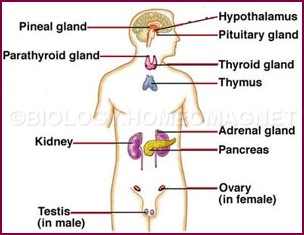Physiology related pages:
- Physiology
- Human Organ System
- Blood
- Red blood cells
- Hemoglobin
- Blood Clotting Process
- Blood Group Types
- Rh Factor
- Blood Pressure
- Normal white blood cell count
- Lymphatic System
- Nervous System
- The Spinal Cord
- Nervous System Function
- Structure of Neuron
- Synapse
- Cranial Nerves
- Autonomic Nervous System
- Endocrine System
- Hormones
- Classification of Hormones
- Pituitary Gland Hormones
- Posterior Pituitary Hormones
- Function of Thyroid Hormone
- Gastrointestinal Hormones
- Where is the Pancreas
- Pancreas Function
- Growth Hormone Deficiency
- Adrenal Cortex
- Enzymes
- Vitamin
- Fat Soluble Vitamins
- Water Soluble Vitamins
- Folic Acid and Vitamin C
- Minerals for the body
- Essential Minerals for the body
- Amino Acids
- Classification of Proteins
- Protein Function
- Protein Properties
- Types of Fatty Acids
- Lipids
- Lipid Classification
- Respiratory System
- Mechanism of Breathing
- Respiratory System Disorders
- Cardiovascular System
- Immunology
- Immune System
- Human muscles
- Properties of Muscles
- Skeletal Muscle
- Muscle contraction
- Heart Muscle
- Smooth Muscle
- BMR
- BMR Measurement
- Bone Joint
- Mouth Cavity
- Male Reproductive System
- Human Urine
- Abnormal constituents of urine
- Sweat Glands
- Mental Illness
- Digestion of carbohydrates
- Protein Digestion
The endocrine system comprises of definite specialized ductless (endocrine) glands or tissues which secrete some chemical substances i.e. hormones into the bloodstream through which they are carried to different parts of the body, and they produce regulatory effects on specific target tissues. Thus, the hormones act like chemical messengers for co-ordination of the body functions.
The nervous and endocrine systems act in different ways; these two systems were earlier thought to be independent of each other. But now it is well established that many interrelationships exist between these two systems. The nervous system plays an important role in regulating the release of many hormones, and the Endocrine System (hormones) also influence the function of nervous system either directly or indirectly. So, it can be say that proper functioning of the body is maintained by a joint and coordinated action of the two systems that is the nervous system and the endocrine system.
Glands of the Endocrine System
The glands which have no excretory duct and whose secretions enter directly into the bloodstream are called ductless glands or endocrine system glands. The word 'endocrine' means 'internal secretion'. Ordinary glands (having an excretory duct) secrete their products into the duct through which the secretions are carried to the site of their action; these are called exocrine glands, e.g., salivary gland, liver, sweat gland etc. On the other side, since the endocrine glands are devoid of ducts, they secrete their products i.e. hormones into the bloodstream i.e. venous blood emerging from them. The hormones are transported throughout the body by the circulating blood, and they exert regulatory influence on various tissues. Examples of endocrine glands are pituitary, thyroid, adrenal glands etc. Besides the typical endocrine glands i.e., those glands which have endocrine function only, certain specialized tissues present in different parts of the body also secrete some hormones (or regulatory chemical substances) into the blood stream (or tissue fluid); these tissues are also included in the endocrine system.
Some Characteristics of Endocrine System Glands
i) Anatomical : It must be ductless and highly vascular for supply of raw materials to it and drainage of hormones from it. ii) Chemical: It must be able to synthesize a definite hormone which is secreted into the blood leaving the organ. iii) Functional: The material secreted must have some definite physiological actions; this can be evidenced by the fact that surgical removal of the organ would lead to destruction of certain physiological functions.
Classification of Endocrine System Glands
Endocrine system glands or simply the endocrine tissues may be classified into the following groups:— i) Classical (or ordinary) endocrine glands: These are typical ductless glandular tissues. They secrete'the hormones into the bloodstream which act on some distant target tissues. Examples of such glands are anterior pituitary, thyroid, adrenal cortex etc. ii) Mixed glands: This group includes those endocrine system glands which are structurally and functionally both exocrine and endocrine in nature. Pancreas, stomach, small intestine etc., are good examples of mixed exo-endocrine glands because each of these secretes a digestive juice (exocrine) as well as some hormones. iii) Neuro-endocrine glands: These are specialized neural tissues having endocrine functions i.e., they secrete their products such as, neurohormones or neurosecretions into the bloodstream which act at a distant site. Such neural cells are called neurosecretory cells. Examples of this group are adrenal medulla, posterior pituitary, hypothalamus, pineal glands etc.
iv) Specialized endocrine tissues: This group includes certain organs which are fundamentally not endocrine system glands but they have some other important functions in the body; they produce or facilitate in the production of some hormones or hormone like chemical messengers. Examples of such organs are thymus, kidney, skin, heart etc. These organs are not endocrine system glands as a whole; somewhat they contain some specialized endocrine tissues.


